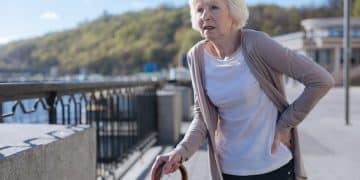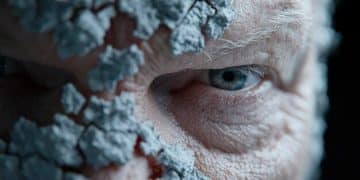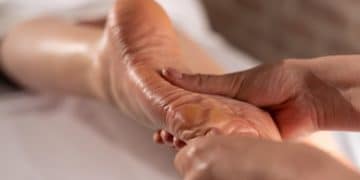Senior Skin Health: Sun Damage & Cancer Prevention
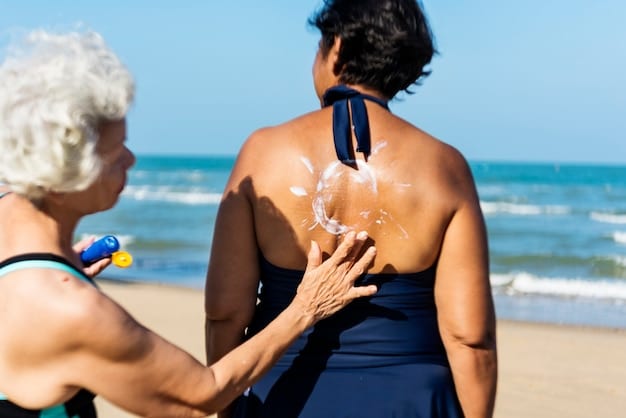
Senior skin health requires diligent protection against sun damage and skin cancer, encompassing consistent sun protection, regular skin screenings, and understanding age-related skin vulnerabilities to ensure long-term dermatological well-being.
As we age, our skin undergoes significant changes, making it more susceptible to environmental aggressors, particularly the sun’s harmful rays. Protecting senior skin health: protecting against sun damage and skin cancer becomes not just a cosmetic concern, but a critical aspect of overall well-being and longevity. Understanding these vulnerabilities and implementing effective strategies is paramount for a healthier future.
Understanding the Aging Skin and Its Vulnerabilities
The passage of time inevitably leaves its mark on our skin, transforming its structure and function. As we journey through our senior years, these changes often accelerate, rendering the skin more fragile and predisposed to damage. Comprehending these intrinsic transformations is the first step towards effective protection.
One of the most noticeable alterations is the thinning of both the epidermis and dermis, the foundational layers of our skin. This reduction in thickness makes the skin more transparent, revealing underlying blood vessels, and significantly diminishes its protective barrier. Moreover, the collagen and elastin fibers, which are responsible for skin’s firmness and elasticity, degrade and become disorganized. This leads to reduced resilience, making the skin more prone to bruising, tearing, and slower wound healing.
Reduced Natural Defenses and Increased Sensitivity
Aging skin exhibits a diminished capacity to defend itself against external threats. The number and function of Langerhans cells, crucial immune cells residing in the epidermis, decrease, impairing the skin’s ability to detect and fight off pathogens and abnormal cells. This immunological decline can contribute to a higher incidence of skin infections and potentially, skin cancers.
- Decreased melanin production, responsible for skin pigmentation and natural UV protection, offers less inherent defense against solar radiation.
- Reduced sebum production by oil glands can lead to chronic dryness, flakiness, and itching, compromising the skin’s barrier function.
- Slower cell turnover rates mean that damaged skin cells persist longer, accumulating genetic mutations that can precede cancerous growths.
Furthermore, the nerve endings in aging skin can become less sensitive, leading to a reduced perception of pain, pressure, and temperature. While this might seem advantageous, it can inadvertently delay the recognition of skin injuries or early signs of sun damage. The cumulative effect of these changes underscores the urgent need for proactive and consistent skincare, especially concerning sun exposure.
The inherent changes in senior skin structure and function, coupled with a weakened immune response and reduced natural defenses, collectively elevate its vulnerability. This heightened susceptibility makes it imperative for seniors to adopt comprehensive strategies to shield their skin, particularly from the pervasive threat of solar radiation, which can exacerbate existing issues and trigger new ones.
The Cumulative Impact of Sun Exposure on Mature Skin
Decades of sun exposure, often without adequate protection, leave an undeniable and often detrimental legacy on our skin. For mature adults, this cumulative damage, known as photoaging, manifests in various forms, significantly increasing the risk of both benign and malignant skin conditions.
Sunlight, specifically its ultraviolet (UV) radiation components (UVA and UVB), penetrates the skin, causing damage at a cellular level. UVA rays, which penetrate deeper, contribute to premature aging, breaking down collagen and elastin. UVB rays are the primary cause of sunburn and are directly implicated in DNA damage leading to skin cancer. Over time, this consistent assault overwhelms the skin’s repair mechanisms, leading to visible and pathological changes.
Common Manifestations of Photoaging
The visible signs of photoaging are often what prompt individuals to seek dermatological advice. These include deepening wrinkles, fine lines, and changes in skin texture, manifesting as roughness and leathery appearance. Pigmentation irregularities are also common, such as age spots (solar lentigines), which are flat, brown or black spots, and uneven skin tone.
- Actinic Keratoses (AKs): These are rough, scaly patches that develop on sun-exposed areas. AKs are considered precancerous lesions, with a small but significant potential to evolve into squamous cell carcinoma.
- Telangiectasias: Often referred to as “spider veins,” these are small, dilated blood vessels visible on the skin’s surface, particularly on the face.
- Elastosis: A yellowish, thickened, and often furrowed skin appearance resulting from the excessive accumulation of abnormal elastin in the dermis.
Beyond the cosmetic concerns, the more serious implications of photoaging lie in the increased risk of skin cancers. Basal cell carcinoma (BCC), squamous cell carcinoma (SCC), and melanoma are all strongly linked to UV exposure. BCC and SCC are the most common forms, often appearing on sun-exposed areas like the face, neck, and hands. Melanoma, while less common, is the most aggressive and potentially life-threatening type of skin cancer.
The cumulative effects of sun exposure on mature skin are profound, accelerating the aging process and, more critically, elevating the risk of various skin cancers. Recognizing the signs of photoaging and understanding its implications is crucial for seniors to embrace comprehensive sun protection strategies and regular skin screenings as integral components of their health regimen.
Essential Sun Protection Strategies for Seniors
Given the heightened vulnerability of senior skin to sun damage, implementing robust and consistent sun protection strategies is non-negotiable. These measures extend beyond mere sunscreen application, encompassing a holistic approach to shield the skin from harmful UV radiation.
The cornerstone of sun protection involves minimizing direct exposure during peak sunlight hours, typically between 10 AM and 4 PM. During these times, UV radiation is most intense, and even short periods of exposure can cause significant harm. If outdoor activities are unavoidable, seeking shade under trees, umbrellas, or shaded structures is paramount.
Comprehensive Sunscreen Application
Choosing and correctly applying sunscreen is a critical defense mechanism. For seniors, a broad-spectrum sunscreen with an SPF of 30 or higher is recommended, providing protection against both UVA and UVB rays. Water resistance is also beneficial, especially if engaging in activities that cause sweating.
- Apply sunscreen generously to all exposed skin at least 15-30 minutes before going outdoors.
- Reapply every two hours, or more frequently if swimming or sweating heavily.
- Pay particular attention to commonly overlooked areas such as the back of the neck, ears, scalp (if balding or thinning hair), tops of feet, and back of hands.
Beyond sunscreen, protective clothing serves as an effective physical barrier against UV rays. Opt for lightweight, long-sleeved shirts, long pants, and wide-brimmed hats that protect the face, neck, and ears. Many brands now offer clothing with Ultraviolet Protection Factor (UPF) ratings, indicating their effectiveness in blocking UV radiation.
Sunglasses that block 99-100% of both UVA and UVB rays are also vital to protect the delicate skin around the eyes and prevent cataracts. Regular use of sun protection strategies helps mitigate the cumulative damage incurred over decades and plays a crucial role in preventing new skin lesions and cancers. Consistent adherence to these practices is a simple yet powerful investment in long-term skin health for seniors.
Recognizing and Monitoring Skin Changes: What to Look For
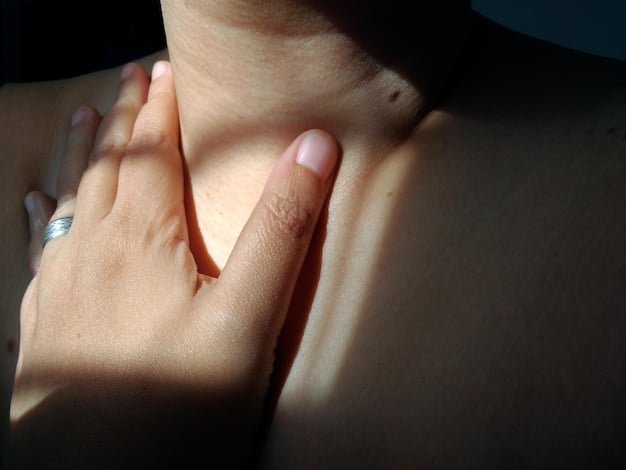
Effective skin cancer prevention in seniors heavily relies on early detection, which starts with diligent self-monitoring and professional screenings. Knowing what new or changing lesions to look for is crucial, as early diagnosis significantly improves treatment outcomes.
The “ABCDE” rule for melanoma detection is a widely recognized and simple guide. While primarily for melanoma, its principles can be applied to monitoring any suspicious skin lesion. It encourages individuals to examine their moles and spots for:
Asymmetry: One half does not match the other half.
Border: The edges are irregular, ragged, notched, or blurred.
Color: The color is not uniform and may include shades of black, brown, and tan. It may also have patches of red, white, or blue.
Diameter: The spot is larger than 6 millimeters (about the size of a pencil eraser), though melanomas can be smaller.
Evolving: The mole or spot is changing in size, shape, color, or elevation, or any new symptoms such as bleeding, itching, or crusting.
Beyond Melanoma: Other Skin Concerns
While melanoma is the most dangerous, basal cell carcinoma (BCC) and squamous cell carcinoma (SCC) are far more common, especially in seniors. BCCs often appear as a pearly, translucent bump, a flat, flesh-colored or brown scar-like lesion, or a bleeding sore that heals and then re-opens. SCCs typically present as a firm, red nodule, or a flat, scaly, crusted patch.
- Any new growth that appears on the skin.
- A sore that does not heal within a few weeks.
- Existing moles or lesions that change in appearance, size, or texture.
- Persistent itching, tenderness, or pain in a specific skin area without clear cause.
Regular skin self-exams, performed monthly, allow seniors or their caregivers to become familiar with their skin’s normal appearance and detect any new or changing lesions. A full-body check should include areas not typically exposed to the sun, such as the scalp, bottoms of feet, and between toes, as skin cancers can occur anywhere.
Professional dermatological check-ups are equally vital. Dermatologists have the expertise and tools to identify suspicious lesions that might be missed during a self-exam. For seniors, annual full-body skin exams are generally recommended, or more frequently if there’s a history of skin cancer or precancerous lesions. Consistent vigilance through self-monitoring and professional oversight is the cornerstone of protecting senior skin health from the dangers of skin cancer.
The Role of Regular Dermatological Screenings and Early Detection
While self-monitoring is essential, the expertise of a dermatologist cannot be overstated, especially for seniors. Regular professional skin screenings are a cornerstone of early detection, significantly improving the prognosis for skin cancer treatment. These examinations go beyond what an individual can observe, utilizing specialized knowledge and techniques to identify subtle or hidden lesions.
During a professional skin screening, a dermatologist systematically examines the entire skin surface, often using a dermatoscope – a handheld device that magnifies and illuminates the skin, allowing for a detailed view of moles and other lesions. This comprehensive approach helps detect suspicious areas that might be overlooked during a self-exam, particularly those on the scalp, back, buttocks, and other hard-to-see areas.
When to Seek Professional Advice
Beyond routine annual screenings, certain signs warrant an immediate visit to a dermatologist. These include any new or changing mole, a sore that doesn’t heal, or any lesion that persistently itches, bleeds, or is painful. Don’t wait for a scheduled appointment if you notice a concerning change; prompt evaluation is critical.
- If you have a personal history of skin cancer.
- If you have a strong family history of melanoma.
- If you have many moles (over 50) or atypical moles.
- If you have spent extensive time in the sun throughout your life, especially if you’ve had multiple severe sunburns.
If a suspicious lesion is identified, the dermatologist may perform a biopsy, which involves removing a small tissue sample for microscopic examination. This procedure is usually quick and performed in the office under local anesthesia. A pathological diagnosis confirms whether the lesion is benign, precancerous, or cancerous, guiding subsequent treatment decisions.
Early detection through regular dermatological screenings is arguably the most powerful tool in combating skin cancer. It allows for interventions at a stage when skin cancers are most treatable, often requiring less invasive procedures and dramatically improving the chances of a complete recovery. For seniors, who carry a lifetime of sun exposure and a higher inherent risk, these screenings are not just recommended but are a vital component of proactive health management.
Lifestyle and Diet: Supporting Skin Health from Within
While external protection and regular screenings are crucial, a holistic approach to senior skin health also incorporates lifestyle choices and dietary habits. What we consume and how we live can significantly impact the skin’s ability to repair itself, maintain its barrier function, and resist environmental damage, including that caused by the sun.
A diet rich in antioxidants plays a vital role in neutralizing free radicals, unstable molecules generated by UV radiation and other environmental stressors. These free radicals can damage skin cells and DNA, contributing to photoaging and skin cancer. Fruits, vegetables, and whole grains are excellent sources of antioxidants such as vitamins C and E, beta-carotene, and selenium.
Hydration and Healthy Fats
Adequate hydration is fundamental for skin health at any age, but particularly for seniors whose skin tends to be drier. Drinking plenty of water helps maintain skin elasticity and moisture, supporting its barrier function. Incorporating healthy fats, such as omega-3 fatty acids found in fatty fish, flaxseeds, and walnuts, also benefits skin health by reducing inflammation and supporting cell membrane integrity.
- Vitamin C: Crucial for collagen production and acts as a powerful antioxidant. Found in citrus fruits, bell peppers, and broccoli.
- Vitamin E: Another antioxidant that helps protect skin cells from damage. Abundant in nuts, seeds, and leafy green vegetables.
- Selenium: Plays a role in DNA repair and antioxidant defense. Found in Brazil nuts, fish, and whole grains.
Beyond diet, lifestyle factors such as regular physical activity promote healthy circulation, delivering essential nutrients and oxygen to skin cells. Quitting smoking, if applicable, is also paramount, as smoking accelerates skin aging and increases the risk of various cancers, including skin cancer. Moderating alcohol intake can also prevent dehydration and inflammatory responses that negatively impact skin.
Managing stress through practices like meditation, yoga, or spending time in nature can also have a positive impact on skin health, as chronic stress can exacerbate inflammatory skin conditions. By adopting a balanced diet, staying hydrated, engaging in physical activity, and making conscious healthy lifestyle choices, seniors can significantly bolster their skin’s intrinsic defenses, complementing external sun protection measures and fostering resilient skin from within.
Addressing Existing Sun Damage and Precancerous Lesions
For many seniors, decades of sun exposure mean that some degree of sun damage and potentially precancerous lesions already exist. While prevention is key, effectively addressing existing issues is equally important for maintaining senior skin health and preventing the progression to more serious conditions.
The most common precancerous lesions, actinic keratoses (AKs), are a primary focus. These rough, scaly patches are a warning sign, indicating significant sun damage and a risk of evolving into squamous cell carcinoma (SCC). Early and effective treatment of AKs can prevent this progression, making regular monitoring and treatment crucial.
Treatment Options for Actinic Keratoses and Sun Damage
Dermatologists employ various methods to treat AKs, tailored to the number, size, and location of the lesions, as well as the patient’s overall health and preferences.
- Cryotherapy: Freezing the lesions with liquid nitrogen, causing them to blister and peel off. This is a common and effective method for isolated AKs.
- Topical Medications: Prescription creams containing active ingredients like 5-fluorouracil, imiquimod, or diclofenac are applied over several weeks to treat widespread sun damage and multiple AKs.
- Photodynamic Therapy (PDT): Involves applying a photosensitizing solution to the skin, which is then activated by a special light source, targeting and destroying abnormal cells.
- Curettage and Electrocautery: Scraping off the lesion with a sharp instrument and then burning the base with an electric needle to destroy remaining abnormal cells.
Beyond treating precancerous lesions, addressing the visible signs of sun damage can also improve skin health and appearance. Procedures like chemical peels, laser resurfacing, and dermabrasion can help reduce pigmentation, improve skin texture, and minimize fine lines, contributing to healthier-looking skin.
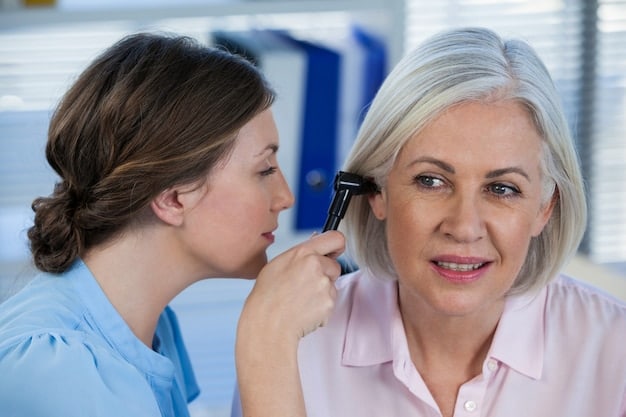
It’s important for seniors to have an open dialogue with their dermatologist about their skin concerns, including existing sun damage. A personalized treatment plan can effectively manage precancerous lesions, alleviate discomfort from severely sun-damaged skin, and help prevent the onset of new skin cancers. Proactive management of existing damage is as vital as ongoing prevention in the comprehensive care of senior skin.
| Key Point | Brief Description |
|---|---|
| ☀️ Sun Protection | Use SPF 30+ sunscreen, wear protective clothing, and seek shade during peak hours. |
| 🔍 Self-Exams | Regularly check skin using the ABCDE rule for moles or new lesions. |
| 👩⚕️ Dermatologist Visits | Schedule annual professional skin screenings for early detection and treatment. |
| 💧 Healthy Lifestyle | Maintain a diet rich in antioxidants and stay hydrated to support skin health. |
Frequently Asked Questions about Senior Skin Health
▼
Senior skin becomes thinner, drier, and less elastic, making it more vulnerable to damage from sun exposure, slower to heal, and more susceptible to infections and skin cancers. Proactive care is essential to maintain skin integrity and prevent serious conditions as we age.
▼
Signs of sun damage often include age spots (solar lentigines), fine lines and wrinkles, rough or leathery texture, and telangiectasias (spider veins). Precancerous lesions like actinic keratoses are also common indicators of significant sun-induced damage.
▼
It is generally recommended that seniors have a full-body skin exam by a dermatologist at least once a year. Individuals with a history of skin cancer, many moles, or significant sun exposure may require more frequent check-ups to ensure early detection.
▼
Absolutely. A diet rich in antioxidants from fruits and vegetables, adequate hydration, and healthy fats can support skin repair and protect against cellular damage. Regular exercise improves circulation, benefiting skin, while avoiding smoking and minimizing alcohol intake enhances overall skin vitality.
▼
No, it’s never too late. While past damage cannot be completely undone, implementing consistent sun protection now can prevent further damage and reduce the risk of new skin cancers. Treating existing precancerous lesions is also crucial for preventing their progression and maintaining long-term skin health.
Conclusion
Protecting senior skin health from the pervasive threats of sun damage and skin cancer is a multifaceted but essential endeavor. By understanding the unique vulnerabilities of aging skin, consistently applying robust sun protection strategies, vigilant self-monitoring, and prioritizing regular professional dermatological screenings, seniors can significantly mitigate their risks. Furthermore, embracing a holistic approach that includes a nutritious diet and healthy lifestyle choices provides crucial support from within. The journey to healthy skin in our later years is an ongoing commitment, but one that undeniably contributes to a higher quality of life, greater comfort, and ultimately, enhanced longevity. Proactive care remains the most powerful defense, empowering seniors to enjoy their golden years with healthier, more resilient skin.


